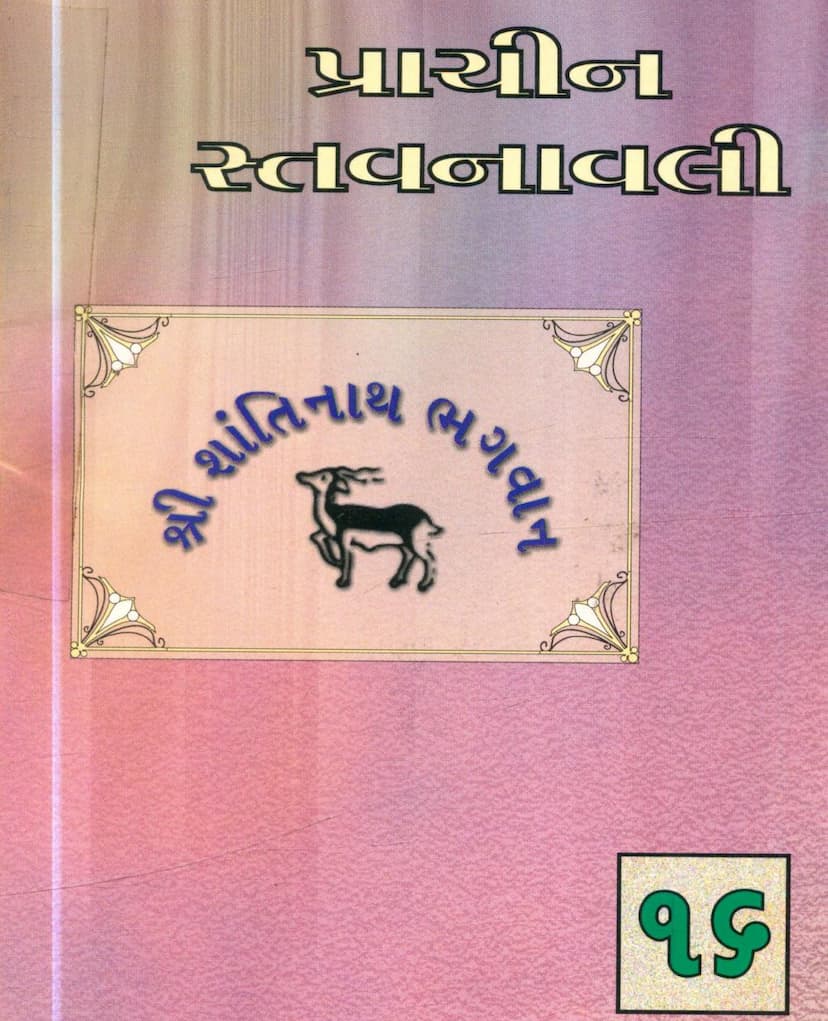Prachin Stavanavli 16 Shantinath
Added to library: September 2, 2025

Summary
This document is a collection of "Stavans" (devotional hymns or songs) dedicated to Lord Shantinath, the 16th Tirthankara in Jainism. Here's a comprehensive summary:
Overall Purpose:
The book, titled "Prachin Stavanavali 16 Shantinath" (Ancient Hymn Collection of Shantinath), compiled by Hasmukhbhai Chudgar, is a compilation of devotional poems and hymns in Gujarati, honoring Lord Shantinath. It aims to foster devotion and spiritual understanding among Jain followers.
Key Content:
- Introduction and Praise of Namokar Mantra: The initial pages (2-3) highlight the significance of the Namokar Mahamantra, describing it as containing the essence of all scriptures and capable of bestowing immense benefits, including material prosperity and spiritual liberation.
- Foreword by Pandit Nandibhushanvijayji M.: This section (Page 4) emphasizes that devotion to the "Paramatma" (Supreme Soul) is a powerful means for the soul to become one with the divine. It mentions the joy of compiling these ancient hymns for the benefit of the Sangha (Jain community) and expresses a wish to be reunited with the Paramatma.
- Index of Hymns: Pages 5-8 provide a detailed index, listing various authors and the page numbers of their respective hymns dedicated to Lord Shantinath. This demonstrates the extensive nature of the collection, featuring hymns from numerous respected Jain scholars and monks.
- Chaitra Vandan Vidhi (Ritual of Worship): Pages 9-14 outline the standard Jain ritual of "Chaitra Vandan," which includes specific sutras (prayers) like Ichhami Khama Saman, Iriyavahiyam, Annath, and Logass. This section provides the verses and their meanings, guiding devotees on how to perform the ritual.
- Individual Hymns (Stavans): The majority of the book (Pages 15-74) consists of the actual hymns. Each hymn is attributed to a specific author and often includes a description of the meter or "deshi" (tune) it should be sung in. These hymns explore various aspects of Lord Shantinath's life, virtues, and the path to spiritual liberation.
Themes and Content of the Hymns:
The hymns cover a wide range of devotional themes, including:
- Lord Shantinath's Life and Teachings: Many hymns recount Lord Shantinath's birth, his divine lineage (from King Vishvasena and Queen Achira), his reign as a Chakravarti (universal monarch), his renunciation, attainment of Kevala Jnana (omniscience), and his ultimate liberation (Nirvana).
- His Virtues: The hymns praise his qualities of peace, compassion, detachment, omniscience, and his role as a guide and savior of humanity. They often describe his physical appearance, such as his golden complexion and the auspicious symbols on his body.
- Devotional Practices: They emphasize the importance of devotion, faith, meditation, and adherence to Jain principles (like non-violence, truthfulness, non-possessiveness, chastity, and non-attachment).
- The Path to Liberation (Moksha): Many hymns offer guidance on how to overcome worldly attachments, karmic bonds, and achieve spiritual liberation through devotion to Lord Shantinath and the practice of Jain dharma.
- Personal Devotion and Yearning: Several hymns express the personal feelings of the devotees, their yearning for Lord Shantinath's darshan (sight) and grace, and their gratitude for his teachings.
- Metaphorical and Allegorical Language: The hymns often employ rich metaphors and symbolism, comparing Lord Shantinath to the moon, the sun, a wish-fulfilling tree, and a source of nectar, to illustrate his divine nature and benevolent qualities.
- Interactions with Other Jain figures: Some hymns may reference interactions with other Tirthankaras, enlightened souls, or deities, reinforcing the interconnectedness of the Jain spiritual cosmos.
Authors:
The book features a prolific collection of hymns from numerous renowned Jain Acharyas, Upadhyayas, and Muni Maharajs, including:
- Shri Virvijayji
- Shri Padmvijayji
- Shri Gyanvimalji
- Shri Jinrangji
- Shri Udayratnaji
- Shri Vimalvijayji
- Shri Anandghanji
- Shri Yashovijayji
- Shri Bhanvijayji
- Shri Anandvardhanji
- Shri Laxmivimalji
- Shri Manvijayji
- Shri Gyanvimal Suriji
- Shri Bhavvijayji
- Shri Vinayvijayji
- Shri Harkhchandji
- Shri Nayvijayji
- Shri Rishabhsagarji
- Shri Udayratnaji
- Shri Jinvijayji
- Shri Hansratnaji
- Shri Mohanvijayji
- Shri Ramvijayji
- Shri Kantivijayji
- Shri Nyaysagarji
- Shri Padmvijayji
- Shri Vijaylakshmisuri
- Shri Kirtivimalji
- Shri Danvimalji
- Shri Vineetvijayji
- Shri Amrutvijayji
- Shri Pramod sagarji
- Shri Bhanuchandji
- Shri Khushalmuni
- Shri Chaturvijayji
- Shri Devchandji
- Shri Jivanvijayji
- Shri Danvijayji
- Shri Meghvijayji
- Shri Kesharvimalji
- Shri Kanakvijayji
- Shri Ruchirvimalji
- Shri Bhavprabhsuriji
- Shri Ratnavijayji
- Shri Manekmuniji
- Shri Deepvijayji
- Shri Dharmkirti Gani
- Shri Swarupchandji
- Shri Yashvijayji
- Shri Gyanvimalji
- Shri Gunvilasji
- Shri Jagjivanji
- Shri Jinharsji
- Shri Yashovijayji
- Shri Mukti vijayji
- Shri Jeevvijayji
Biographical Information of Lord Shantinath:
The last page (Page 76) provides a concise summary of Lord Shantinath's life:
- Name: Shantinath Bhagwan
- Tirthankara Number: 16th
- Father's Name: Vishvasena
- Mother's Name: Achirarani
- Birthplace: Gajpuri (Hastinapur)
- Birth Constellation/Sign: Meṣha (Aries)
- Lifespan: 1 Lakh years
- Body Measurement: 40 Dhanush (a unit of measurement)
- Body Color: Golden hue
- Number of Wives: 64,000
- Number of Sadhus: 1600
- Number of Sadhvis: 64,000
- Chhadmastha Period (period before omniscience): 1 year
- Sponsorship Tree: Nandivriksha
- Chief Gandhar (chief disciple): Not explicitly mentioned here but typically a Ganadhar is the chief disciple.
- Adhishthayak Yaksha: Garuda
- Adhishthayika Yakshini: Nirvani Devi
- First Gandhar: Not explicitly mentioned.
- First Arya (chief female disciple): Suchi (as mentioned in the list of authors)
- Moksha Seat: Sametshikhar
- Kalyanaks (auspicious events):
- Chyavan (descent from heaven): Shravan Vad 7
- Birth: Vaishakh Vad 13
- Initiation (Deeksha): Vaishakh Vad 14
- Keveljnana (omniscience): Posh Sud 9
- Moksha (liberation): Vaishakh Vad 13
- Mudra (symbol): Deer
- Number of Bhavas (life forms): 393,000
- Other details: Mentions printer and contact information.
Overall Significance:
"Prachin Stavanavali 16 Shantinath" is a valuable resource for Jain devotees seeking to deepen their understanding and devotion to Lord Shantinath. It serves as a repository of ancient hymns and a guide to performing Jain rituals, contributing to the preservation and propagation of Jain spiritual heritage.